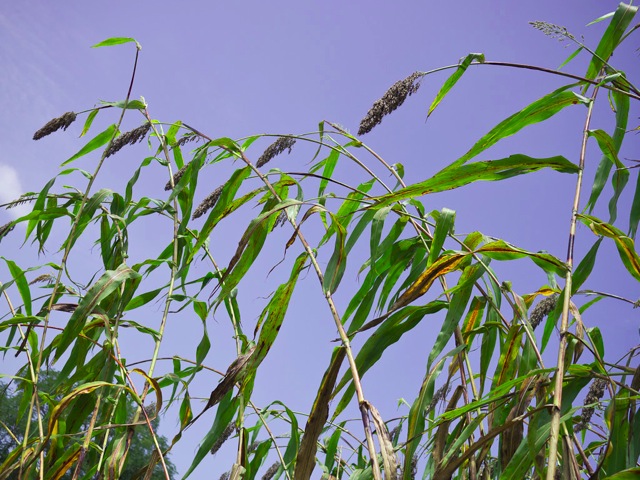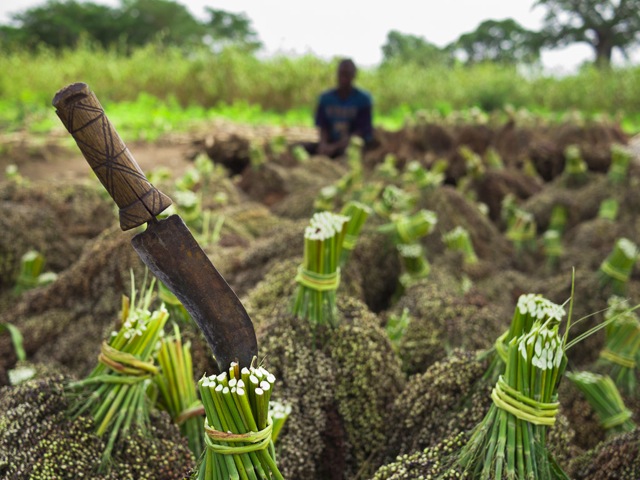Sorghum Harvesting and the Shape of Knives

 Sorghum is a very important crop in Burkina Faso, it constitutes the most affordable food for many of its inhabitants. It is one of the least demanding and least risky crops you can invest in, for even in case rains are scarce it will give a decent production, unlike rice or corn. With it you make to, the most widespread and affordable food here. Women also prepare sorghum beer, or dolo, that is socially very important: in villages, houses become a sort of temporary bar when beer is ready, and in town cabarets, or dolosow or dorobonw, are places for socialising and playing music. Basically no part of the plant is wasted, and every byproduct of the various recipes has a function: for example, when the ripe head is boiled to prepare beer, the first water obtained is characterised by a slightly bitter taste, and is used to preserve the to from going bad. Stems are used to make roofs for appatams, the huts used to hide from the heat of the sun.
Sorghum is a very important crop in Burkina Faso, it constitutes the most affordable food for many of its inhabitants. It is one of the least demanding and least risky crops you can invest in, for even in case rains are scarce it will give a decent production, unlike rice or corn. With it you make to, the most widespread and affordable food here. Women also prepare sorghum beer, or dolo, that is socially very important: in villages, houses become a sort of temporary bar when beer is ready, and in town cabarets, or dolosow or dorobonw, are places for socialising and playing music. Basically no part of the plant is wasted, and every byproduct of the various recipes has a function: for example, when the ripe head is boiled to prepare beer, the first water obtained is characterised by a slightly bitter taste, and is used to preserve the to from going bad. Stems are used to make roofs for appatams, the huts used to hide from the heat of the sun.
I had to see what the harvest is like, given its importance. Hamidou’s field was one of the first to be harvested, in this case as well people organise themselves in groups that will work at each other’s fields when required. I did a little bit of filming and shot some pictures, then joined a line and started to cut the grains from the stems with my knife. This gave me a couple of interesting insights, that I wasn’t able to observe through my camera’s viewfinder. First, people here have a way of working at things on the ground, a technique of the body, that I am definitely not mastering. They bend with their back straight, legs only slightly flexed. I would tend naturally to crouch, in a position you cannot keep for long. I tried to imitate their bodily stance, and painfully discovered, the day after, that this position stresses the muscles at the back of your legs a lot. Furthermore, I understood something connected to hunting, on the shape of knives.
When I had to buy a knife to bring here, I looked for one with a convex blade profile, in other words a belly, that is useful to skin animals. Most hunting knives are shaped like this. Hunters here use instead knives that almost resemble a sickle, with a concave blade profile. They are peasants’ knives, as I realised cutting sorghum stems. It is much easier to do it with the kind of sickle profile they use, it requires less wrist effort. This because, in the first place, hunters are peasants here, that sometimes go killing animals. On the other hand, even animals with a nice fur like rabbits and wild cats are not skinned. Feathers, hairs and furs are burned and scraped, and the skin is eaten with the meat. The shape of the knife is again useful at scraping hair off a rabbit’s body. By looking at tools one can tell much of the way people use them, but it is by sharing practical activities that I was able to trace this kind of connection between agricultural work and hunting. I know I must look for more of these connections, given the importance of agriculture here. I am also glad the stuff I wrote on embodied, in the first person perspectives seems to work somehow.






